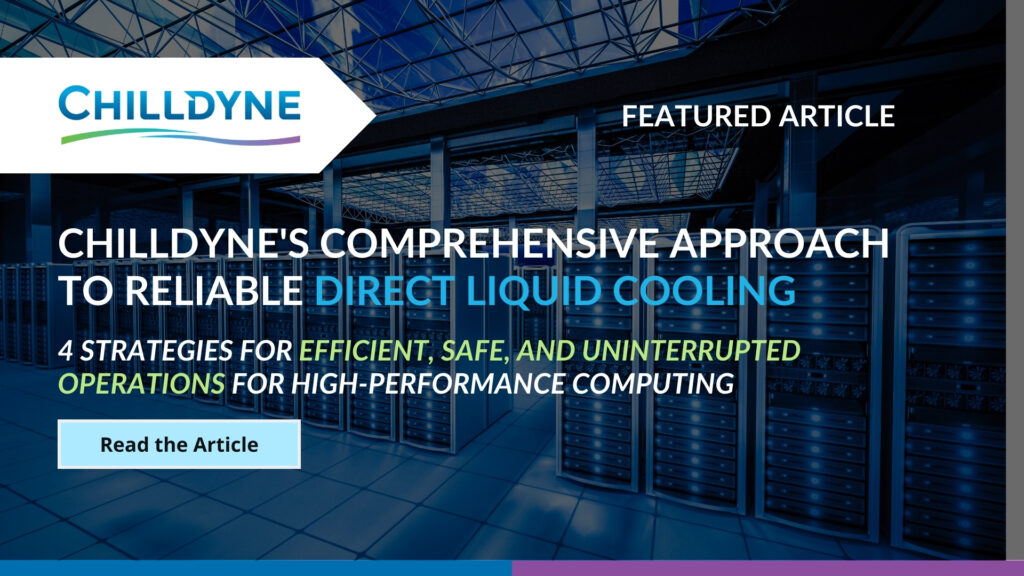Posts by Editor
Chilldyne Launches Liquid Cooling Starter Kit to Modernize and Enable AI in Data Centers
Chilldyne Launches Liquid Cooling Starter Kit to Modernize and Enable AI in Data Centers CARLSBAD, CALIFORNIA, July 16, 2024 — Chilldyne, a leading provider of direct-to-chip liquid cooling solutions, has just released its Data Center Liquid Cooling Starter Kit designed to prepare data centers for the workloads being driven by AI computing. With high density…
Read MoreChilldyne’s Comprehensive Approach to Reliable Direct Liquid Cooling
The rapid advancement of generative AI has led to a surge in high-performance computing and data center heat loads. Liquid cooling has emerged as a powerful solution for managing these increasing thermal challenges. At Chilldyne, our extensive experience in this emerging field has enabled us to develop a comprehensive approach that ensures reliable, efficient, and…
Read MoreFeatured Industry Report: The Future of Liquid Cooling
Featured Report: The Next Generation of Liquid Cooling
Read MoreLeak-Proof Direct Liquid Cooling Demo (Supercut Video)
Check out Chilldyne’s liquid cooling technology designed for AI Data Centers & HPC! The innovative negative pressure loop ensures no coolant leaks. Chilldyne’s solution eliminates the need for heavy-duty plumbing, making setup and maintenance a breeze. Say goodbye to leaks with Chilldyne’s fail-safe systems, like this one demonstrated with the Dell PowerEdge R760 server. (Note:…
Read More6 Questions to Ask Your Liquid Cooling Vendor: Reliability, Performance, and Peace of Mind in Data Centers
Selecting the right liquid cooling solution is paramount for optimal data center operations. It’s not just about providing the best cooling efficiency; it’s about ensuring reliability, performance, and peace of mind. Here are six essential questions you should ask your liquid cooling vendor to ensure you choose a system that effectively meets your data center’s…
Read MoreSimplifying the Thermal Qualification Process with Direct Liquid Cooling for Data Center Servers
Thermal qualification for data centers is a process by which the test team validates a system’s thermal performance to ensure safe operating temperatures under multiple test conditions. This is done to model real-world use cases such as workloads from AI or HPC in various cooling configurations. This ensures optimal performance and reliable operation prior to…
Read MoreChilldyne Secures ARPA-E COOLERCHIPS Award to Improve Data Center Efficiency
$550,000 U.S. Department of Energy Grant Powers Chilldyne’s Liquid Cooling Innovations SAN DIEGO, CALIFORNIA, January 22, 2024 — Chilldyne, a leader in liquid cooling technology for data centers and server manufacturers, announces its receipt of a $550,000 award from the Department of Energy’s Advanced Research Projects Agency-Energy (ARPA-E). This grant, part of the COOLERCHIPS funding…
Read MoreChilldyne at SC23
Chilldyne, the leading provider of liquid cooling solutions for AI and high-performance data centers, showcased breakthroughs in liquid cooling for AI and high-performance data centers during SC23, held in Denver, Colorado. Here’s a quick look at the major highlights: 1. ‘Cut the Line’ Demo – Preventing Leaks Before It Happens: Demonstrating our negative pressure technology,…
Read MoreThe Transformative Power of Liquid Cooling: A Sustainable Shift in Data Center Carbon Emissions
The digital age is seeing an exponential rise in data usage, and with that, an associated surge in energy consumption by data centers. Accounting for 3% of global energy use, data centers annually consume over 400 TWh, culminating in a whopping 100 million tons of CO2 emissions. As the scale tips towards higher data demands,…
Read MoreLiquid Cooling Economics: Reducing Costs by 1,400% on Connectors through “Negative Pressure” Technology
Forget expensive, specialized connectors! Chilldyne’s negative pressure technology enables fail-safe, leak-proof liquid cooling solutions that save money. This is by preventing downtime and using generic fluid connectors for major savings. (Generic parts are possible because leaks or broken connectors do not cause downtime on other servers.) If you have a 1,000-server cluster with 2 connector…
Read More









